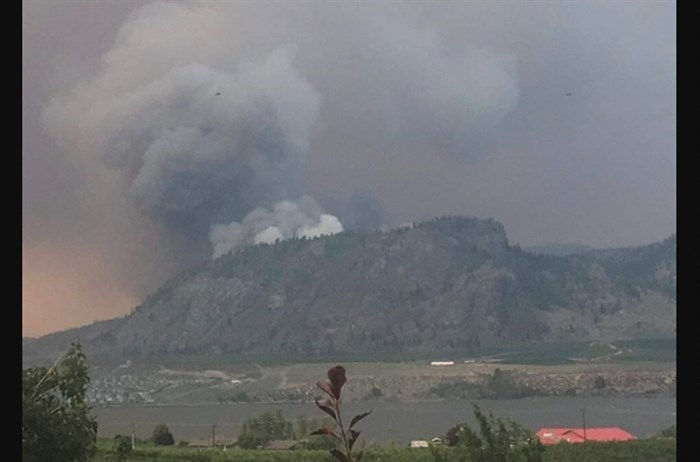
The Nk'Mip wildfire near Osoyoos.
Image Credit: SUBMITTED/B.C. Wildfire
July 21, 2021 - 4:20 PM
Osoyoos Mayor Sue McKortoff wants tourists to stop and assess the situation before they head to her town because the Nk'Mip Creek wildfire raging nearby is complicating life for travellers and residents alike.
"(For people) evacuated from campgrounds or from resorts, the best bet for them would be to return to their home, because a lot of our resorts and hotels are full, so it's not like we can just accommodate lots of people," Makortoff said during a public fire briefing today, July 21.
"I'm absolutely delighted to hear that the town of Princeton has put in some places for people to go and camp for now because several people here were camped in the (grocery store) parking lot, hoping that this would pass quickly and they would be able to get back to enjoying their camping trip."
That's simply not going to happen.
"I just want people to know that tourists are an important part of all of our communities in the Okanagan, but our first job is to make sure that people are safe and people are obeying the rules."
Highlighting the stress on resources, Makortoff said that the sheer number of people moving through the area yesterday as evacuation orders and alerts rolled out made it hard to even find a place to gas up.
So, she said, if you're planning a trip, check before you go. Don't leave your house without calling your resort, motel or campsite and confirming everything is fine.
"This is a very volatile situation and we sure don't want to put people at risk," she said. "And if they are not able to come up and enjoy the Okanagan right now — and they might not wish to in this type of climate— we hope that they will later."
While the Nk'Mip Creek fire is dynamic there has been some good news since it broke out Monday.
No structures have been lost, though its proximity to homes remains a concern to those on the front lines.
Also, the fire is still mapped at 2,000 hectares, though it’s likely to come in 100 to 200 hectares more than that when the smoke clears enough to make a new size estimate, Dale Bojahara, the regional wildfire co-ordination officer for the Kamloops Fire Centre, said.
That’s much better than it could have been give the forecast for wind.
“We’re having some reasonable success on a number of points for the fire,” Bojahara said.
“We're up to 37 personnel on the incident at this point, with five helicopters and 13 pieces of heavy equipment so a lot of work going on with that heavy equipment right now on a number of flanks.”
On the eastern flank, crews are trying to put a control line in. The same goes for the western flank, which is the area closest to the community.
There they are trying to build a better line of security between the fire line and the community.
B.C. Wildfire also have 12 members working the Shrike Hill area, installing sprinklers around some of those homes in that area, he said.
Moving ahead, wind may again become a complicating factor, particularly if it shifts direction.
"That is one of our main concerns this afternoon as we go into the prime burning period, as everyone likely knows wind has a very major influence on fire behaviour so that's something we'll be watching very closely and with any luck, perhaps, we won't get hit as hard as some of the predictions put out there but certainly we're ready for some heavier winds today and in trying to prepare in advance of that," he said.
"Our objectives remain protecting communities as our primary goal, protecting structures along the fire edge."
He stressed again, as he did yesterday, that it's important that people heed the evacuation orders.
Not doing so is a resources issue and could put both firefighters and those who are refusing to follow the orders. Also, he said keeping the boats cleared of the area is always an issue in a firefight and people should be aware.
The terrain of the firefight is on a lot of rocky ground, rolling hills, with the periodic grassy field with the sagebrush. As it moved higher in elevation, and out of the valley, there's open timber and up more there's more densely packed trees.
"Some of it is unsuitable for heavy equipment. So that's that's always a challenge," he said. "But again, we'll adjust and put the resources where they're going to be most effective."
To contact a reporter for this story, email Kathy Michaels or call 250-718-0428 or email the editor. You can also submit photos, videos or news tips to the newsroom and be entered to win a monthly prize draw.
We welcome your comments and opinions on our stories but play nice. We won't censor or delete comments unless they contain off-topic statements or links, unnecessary vulgarity, false facts, spam or obviously fake profiles. If you have any concerns about what you see in comments, email the editor in the link above.
News from © iNFOnews, 2021